If you’ve ever toyed with the idea with travelling to China, you’ll know that the People’s Republic does not kid around when it comes to their visas. Those who frequent the home of the Great Wall will tell you that you should always apply for an entry visa at least 3 weeks prior to your departure date. The whole process involves booking an appointment at your nearest Chinese Visa Center, filling out online forms that includes bringing along visa photos with very specific dimensions, and waiting around 5 business days where you’ll then need to go back to the visa centre to pick up your passport with the newly minted visa. There are expedited/rush processing requests but even then, expect a 2 business day turnaround and extra fees.
In recent years, you can now apply for multiple entry visas for those of you who anticipate more than 1 trip in the lifespan of your passport (just costs a little extra $$) which has made the process a little less painful but what’s better is there’s now a new and improved 144-hour In-Transit Visa which travellers can apply for at the airport.
So how do you qualify for this mysterious visa?
A FOREWORD FROM WILL
This guest post is from literary extraordinaire and friend Mary Huang. This story developed when I met up with Mary and a few other past co-workers as part of my Tokyo food tour. In a bind, she needed to get to Shanghai while she was in Tokyo but without a China visa what could she do? I’ll share the rest of the story at the bottom but first I’ll hand it over to Mary who will tell you a bit more about how the 144 hour in-transit visa works and how she used it to go to China without a visa.
Read
- Top 10 things to do in Shanghai
- How to get free wifi at Shanghai PVG Airport
- How to spend less than $25 in one day in Shanghai
Where to stay in Shanghai?
- I’ve written an extensive guide on all the primary neighbourhoods of Shanghai with this Where to stay in Shanghai Guide.
In This Article
- How the 144-Hour In-Transit Visa works (Updated 2019)
- The primary requirement
- The 3 Zones
- Official interpretation
- Countries that are eligible
- How the application process works
- The Arrival/Departure Card
- The Arrival Card for Temporary Entry Foreigners
- Applying for the 144-hour visa at airport customs
- Counting 144 hours
- A new Chinese government tool
- Does this work for business travellers?
- Inform your airline
- What about Hong Kong, Macau, and Taiwan?
- Clear no-no’s
- How do you leverage the 144-hour visa?
- The rest of Mary’s story
- Travel Resources For Your Next Trip
How the 144-Hour In-Transit Visa works (Updated 2019)
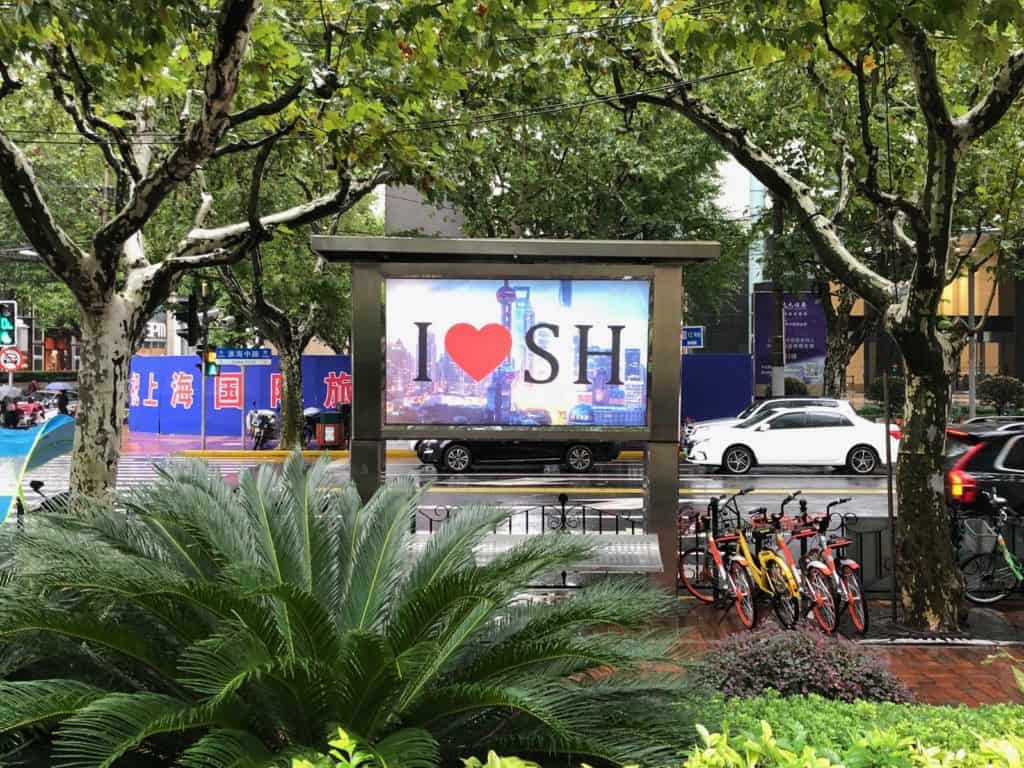
Here’s are the details that you need to know. What’s funny is that there isn’t a good official website from the PRC that goes through all the details. The next best thing is what Travel China Guide has put together.
First off, exactly how many days is 144 hours? It’s 6 days.
The primary requirement
The key is that you must be leaving to a different country from which you arrived. (ie. USA to China to Canada is OK. But Canada to China to Canada is not).
The idea is you’re “in-transit” and just passing through China. This is probably best explained through examples.
- In my case, I started in Tokyo -> transit through Shanghai -> onwards to Toronto
- More typical routes look like this: Toronto -> Beijing -> Bangkok
- This also works on the return flight: Hong Kong -> Shanghai -> Los Angeles
Note that Hong Kong, Macau and Taiwan count as different countries from the PRC so Hong Kong to China to Canada is fine.
What doesn’t work is when there are multiple hops (in different zones) involved:
- Toronto -> Shanghai -> Xi’an -> Seoul
- London -> Beijing -> Shanghai -> New York
Yes Beijing and Shanghai are eligible cities to apply for the visa but you can’t fly to separate parts of the countries that are considered to be different zones (more on that below).
What is interesting to note is that something like this works:
- Singapore -> Shanghai -> Hangzhou -> Malaysia (Shanghai and Hangzhou are in the same zone)
Why is that? Keep reading…
THE MAIN RULE
A -> B: one of three zones in Mainland China -> C
The 3 Zones
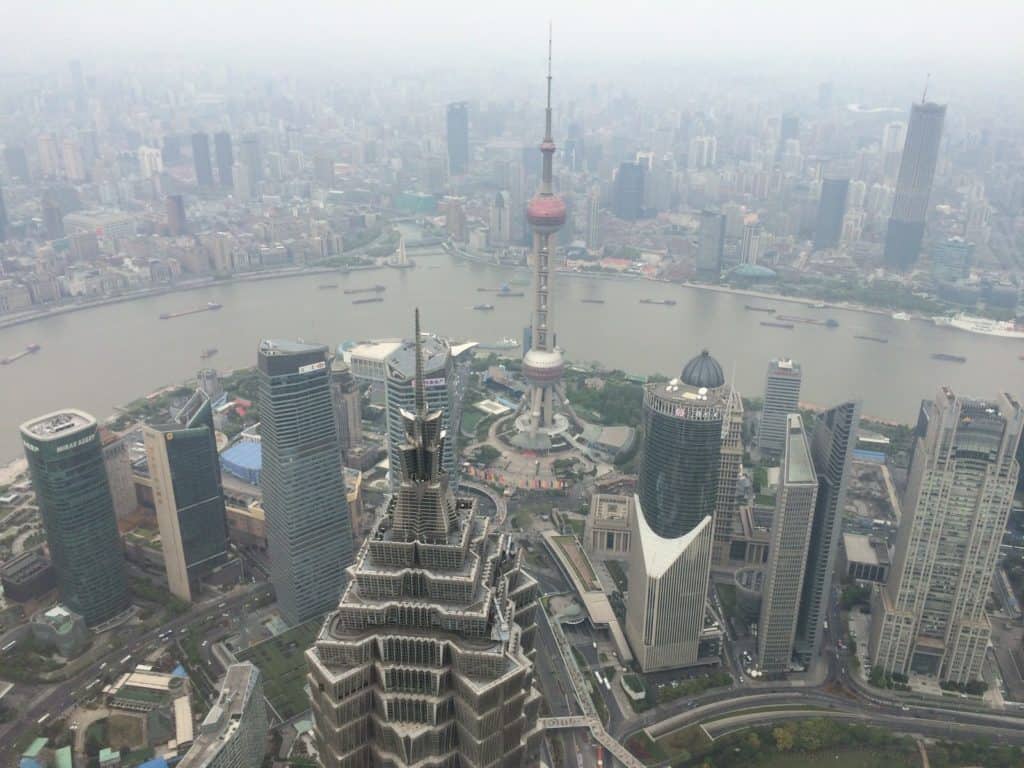
There are 3 defined “zones” and corresponding specific cities where you can apply for this type of visa. This means that this only works at very specific landing areas in China.
Also keep in mind that you can only travel within the zone of which you entered. As of 2018, this is now strictly enforced. This means that if you try to leave this zone, you’ll be stopped at the train station, airport or other port when they ask to see your passport.
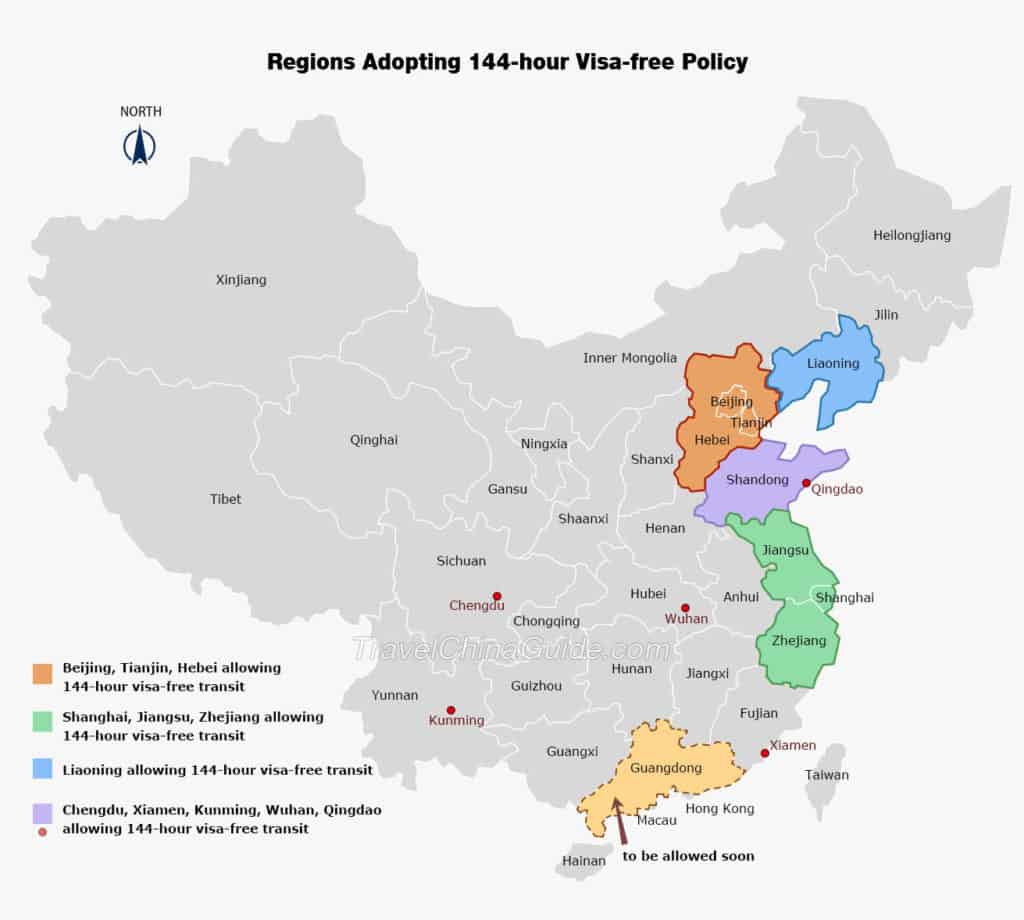
Zone #1: Shanghai, Jiangsu, and Zhejiang
- Shanghai: All air, sea and one railway ports, including Pudong Airport, Hongqiao Airport, Shanghai Port International Cruise Terminal, Wusong Passenger Transport Center and only the Shanghai Railway Station.
- Hangzhou of Zhejiang: Hangzhou Xiaoshan Airport
- Nanjing of Jiangsu: Nanjing Lukou Airport
Zone #2: Beijing, Tianjin and Hebei
- Beijing: Capital International Airport, Beijing West Railway Station
- Tianjin: Binhai International Airport, Tianjin International Cruise Home Port
- Shijiazhuang of Hebei: Zhengding International Airport
- Qinghuangdao of Hebei: Qinhuangdao Port
Zone #3: Liaoning Province
- Dalian: Zhoushuizi International Airport
- Shenyang: Taoxian International Airport
Zone #4: Guangdong Province
- This will include movement within the province including Shenzhen and Guangzhou
- Guangdong’s participation in the 144 hour transit visa is now live as of May 1, 2019
- You are allowed to enter via Guangzhou Airport, Shenzhen Airport, or Jieyang Airport, and travel within Guangdong Province
You must have a departure flight booked within the 144 hour period and be able to show the Customs Officer your booking confirmation and departure details. The departure city must be within the zone that you landed in.
This is why my earlier example of Singapore -> Shanghai -> Hangzhou -> Malaysia works because you landed in Shanghai (Zone #1) and left within 144 hours from Zone #1 which in this case is Hangzhou.
Official interpretation
Straight from the China Embassy (in UAE) is a page with terms of how the 144-hour transit visa should be interpreted.
Countries that are eligible
Not all citizens of countries are eligible for this so it’s best to check this list to make sure you’re safe.
- American countries: United States, Canada, Brazil, Mexico, Argentina, and Chile
- European countries: Austria, Belgium, Czech Republic, Denmark, Estonia, Finland, France, Germany, Greece, Hungary, Iceland, Italy, Latvia, Lithuania, Luxembourg, Malta, Netherlands, Poland, Portugal, Slovakia, Slovenia, Spain, Sweden, Switzerland, United Kingdom, Ireland, Cyprus, Bulgaria, Romania, Ukraine, Serbia, Croatia, Bosnia-Herzegovina, Montenegro, Macedonia (FYROM), Albania, Belarus, Monaco, and Russia
- Asian countries: Korea, Japan, Singapore, Brunei, United Arab Emirates, and Qatar
- Pacific countries: New Zealand and Australia
How the application process works
If you’ve made it through all the requirements, the actual application is really easy and took me through a much shorter line at customs:
- Inform the carrier (airline) when boarding and also ideally beforehand to make sure they won’t cause any problems for you
- Fill an Arrival/Departure Card when you land
- If you are between 14-70, you will need to do a fingerprint scan at the kiosk before customs
- Fill out a separate “Arrival Card for Temporary Entry Foreigners”
- Apply for the 144-hour visa-free stay permit upon arrival at customs (it’s the one with the shortest line)
- Claim your luggage
- Leave the airport
The Arrival/Departure Card
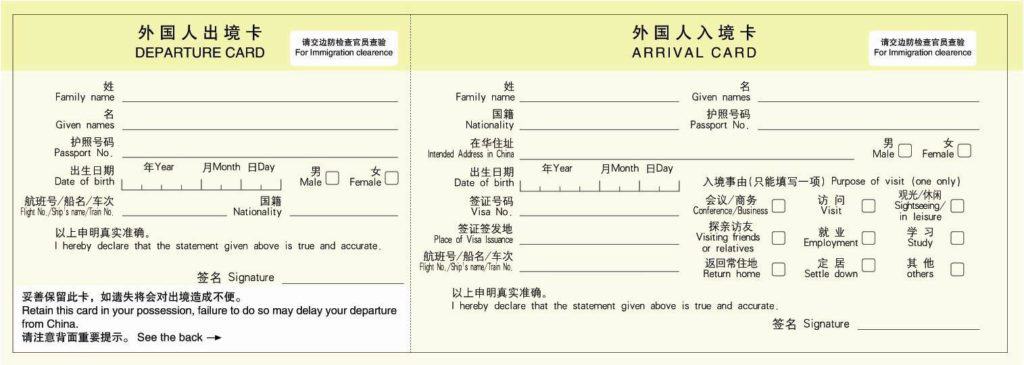
This is the standard card everyone fills out when you arrive in China. What is unclear to me right now is whether you still need to fill this out with the introduction of the new “Arrival Card for Temporary Entry Foreigners”.
The Arrival Card for Temporary Entry Foreigners
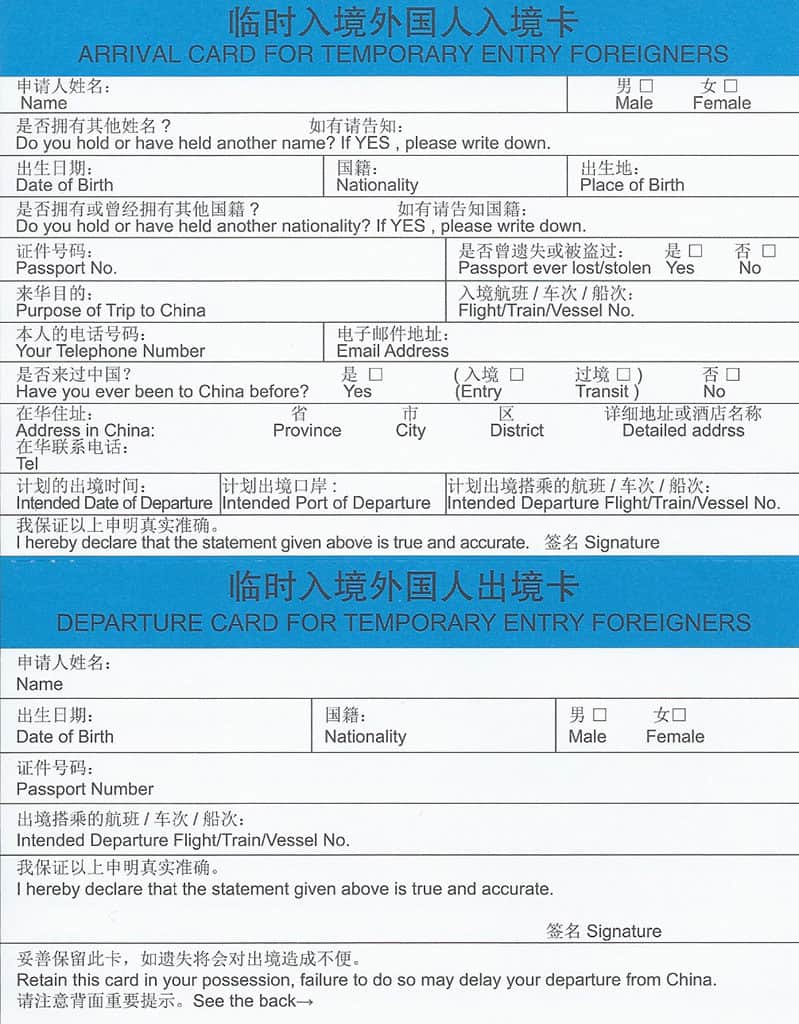
The blue “Arrival Card for Temporary Entry Foreigners” is a new card that was introduced to streamline the 144 hour transit visas. You’ll notice that many of the questions are the same which leads me to believe that the original yellow Arrival/Departure card is not necessary.
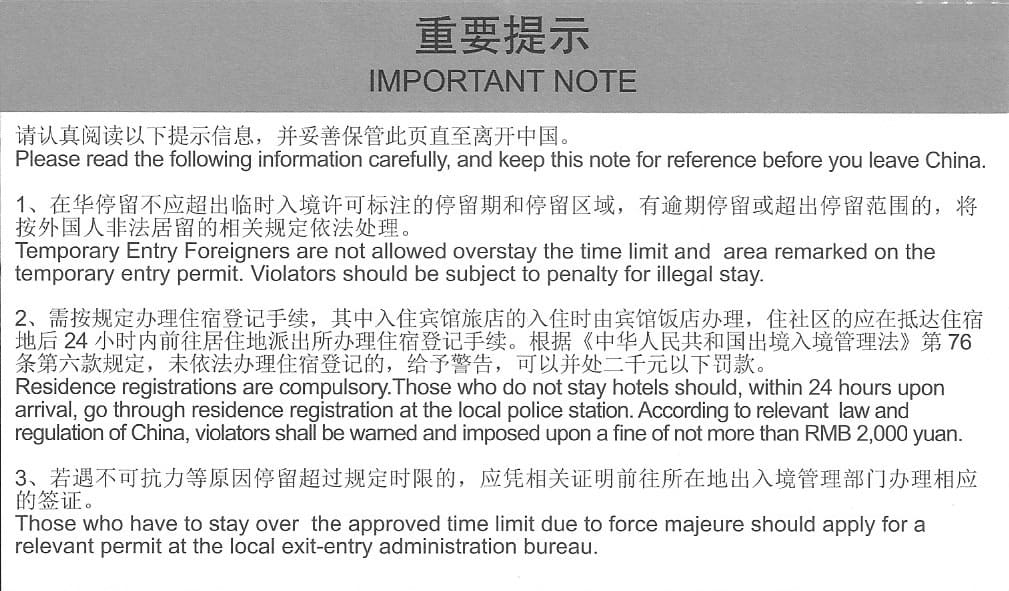
Pay attention to the back of the card as well which I’ve included. More on that later.
Applying for the 144-hour visa at airport customs
When you get into the special line at customs, you present your flight itinerary (including your onward ticket out of China), your passport, and the Arrival/Departure Card + Arrival Card for Temporary Entry Foreigners.
Yes this means that you must have a confirmed ticket to your next destination. You can’t book it while you’re in China.
There are a few things they’ll be concerned with and ask you about:
- Are you only in China for the maximum allowed 144 hours?
- What are you going to be doing in China?
- Where will you be staying in China?
Regarding the last point, they will actually be paying close attention to the address and contact information that you fill out on the Arrival/Departure Card.
In my case, since I was staying with my Grandmother in Shanghai, I provided the residential address and phone number. What I experienced this time is that they actually followed up with me by contacting my cell phone while in Shanghai. I also had to go to the local police office to report my presence as part of the visa.
That sounds a little scary but for regular travellers who will be staying at the hotel, what I’ve read is that they will contact the hotel to confirm your stay at the hotel. In this situation, you do not need to go to the police station.
What does it look like when you land in PVG Shanghai?
I had a chance to take a few photos so you know what to look for when you first land and what direction to walk towards.
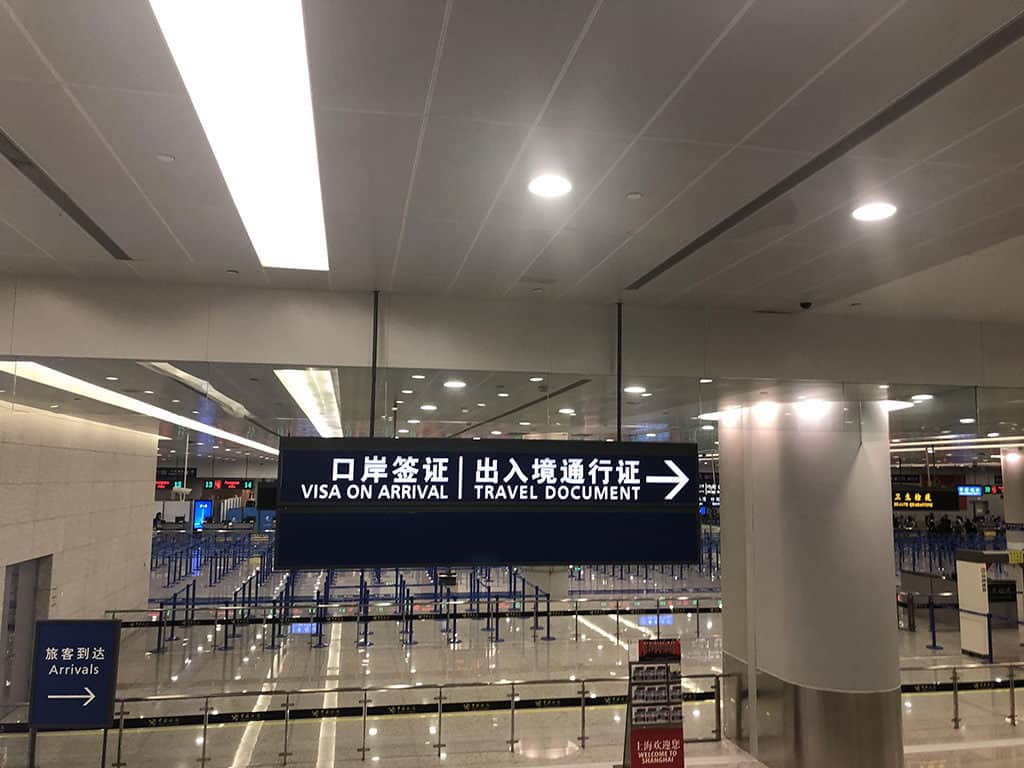
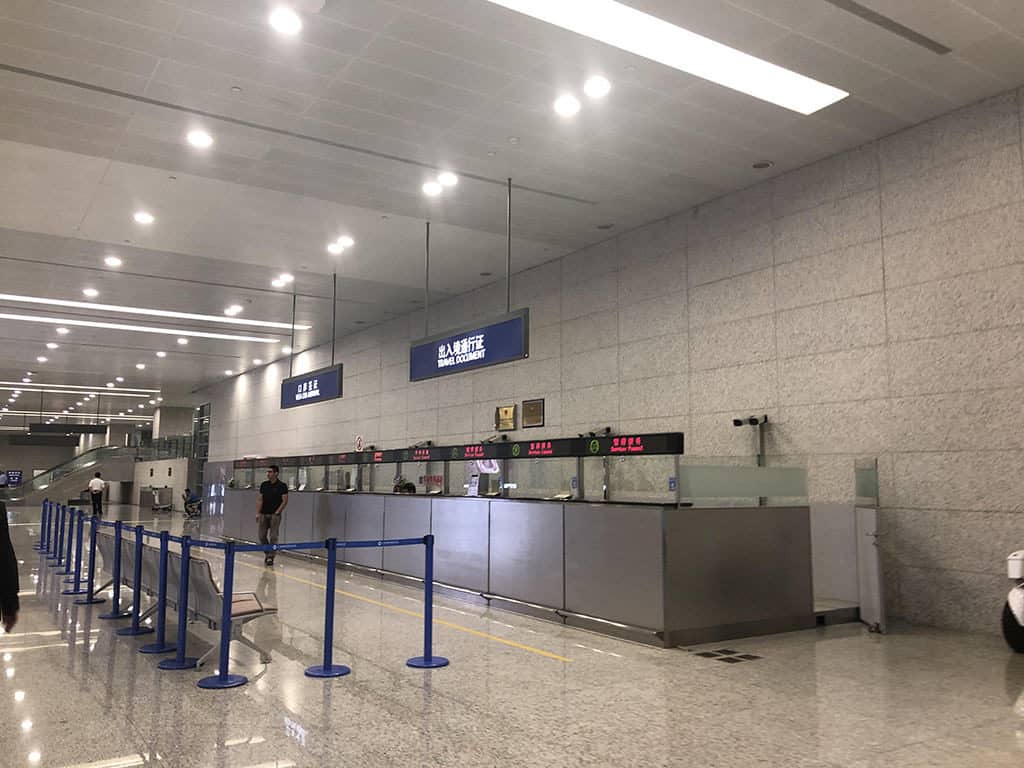
What does it look like when you land in PEK Beijing?
When arrive, look out for this sign to help direct you to where you need to go for the 144-hour transit visa. As a foreigner you’ll have two steps: 1) Do your fingerprint scan and 2) Head to the temporary entry permit application area
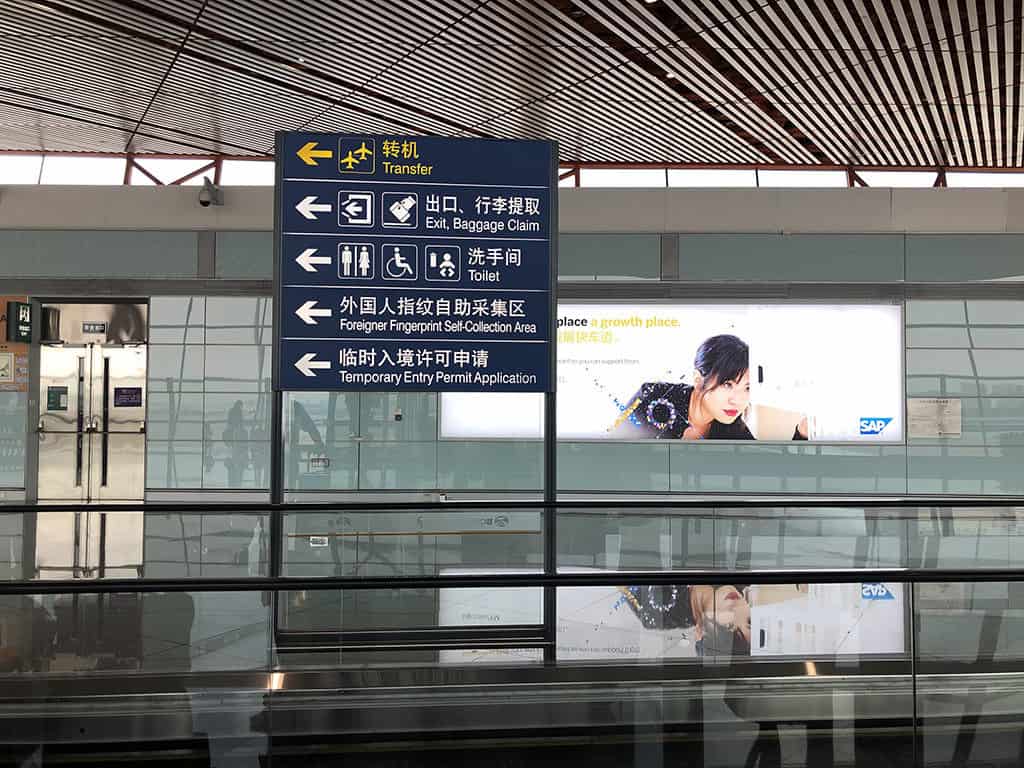
Sorry for the blurry photo of the fingerprint scan stations
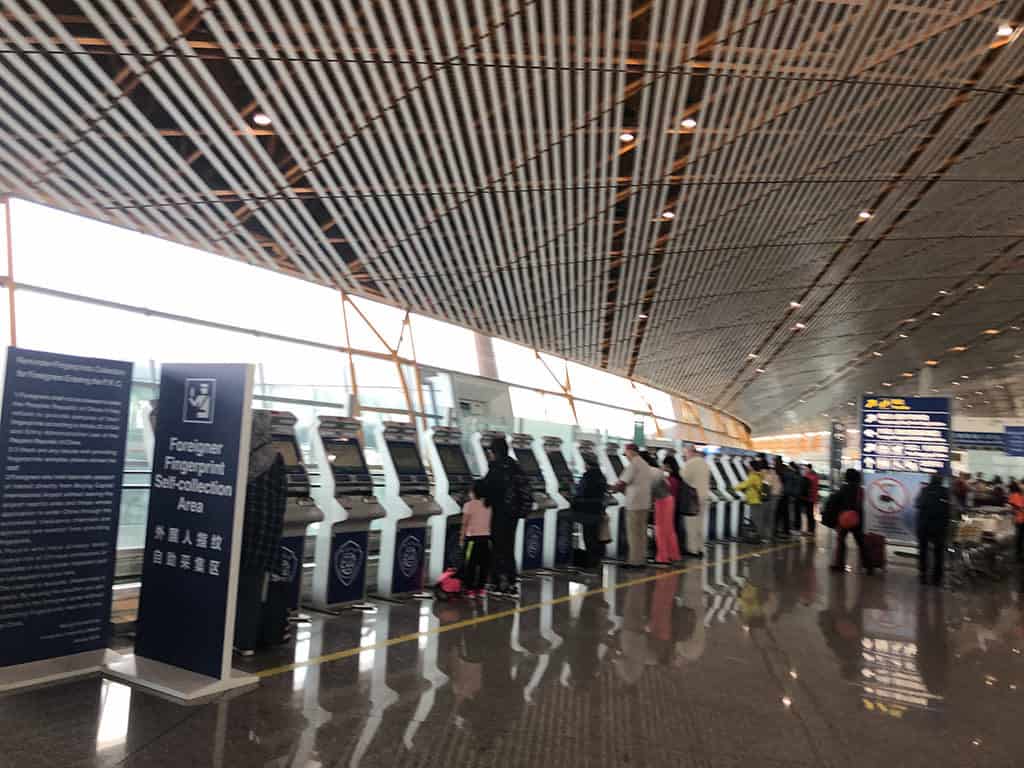
Then head to the transit visa desk which is a separate area and line from everyone else.
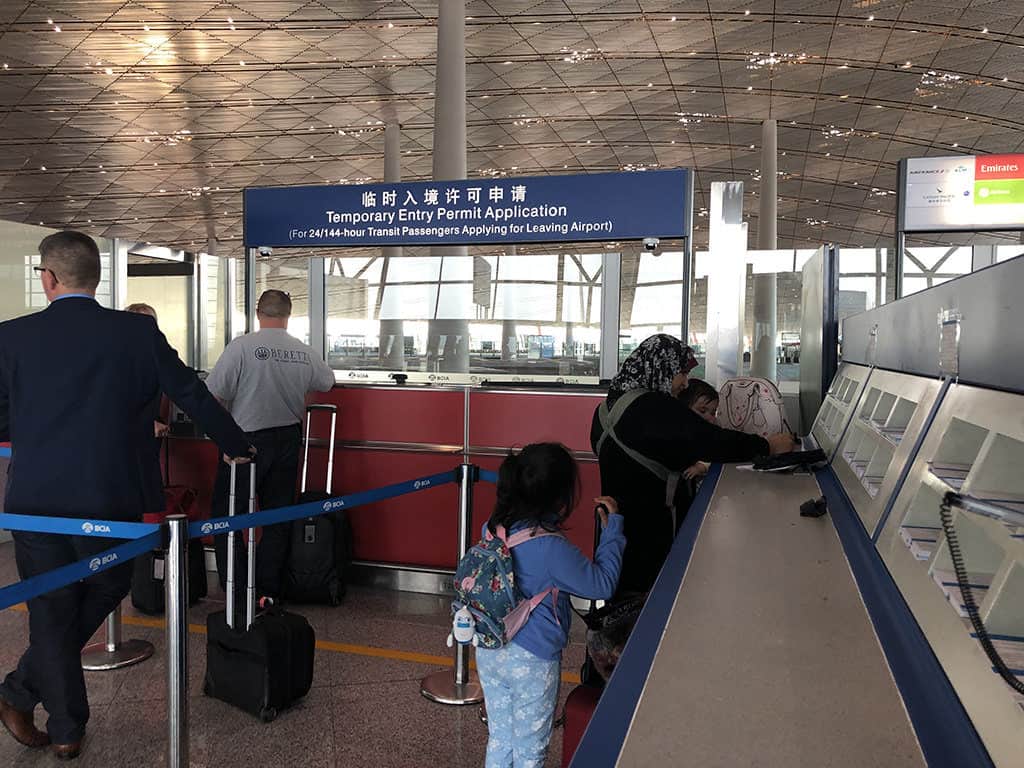
If you look at the right side, there’s a specific form you need to fill out the “Arrival Card for Temporary Entry Foreigners” form. I’d have this and the standard yellow Departure/Arrival card ready as well.
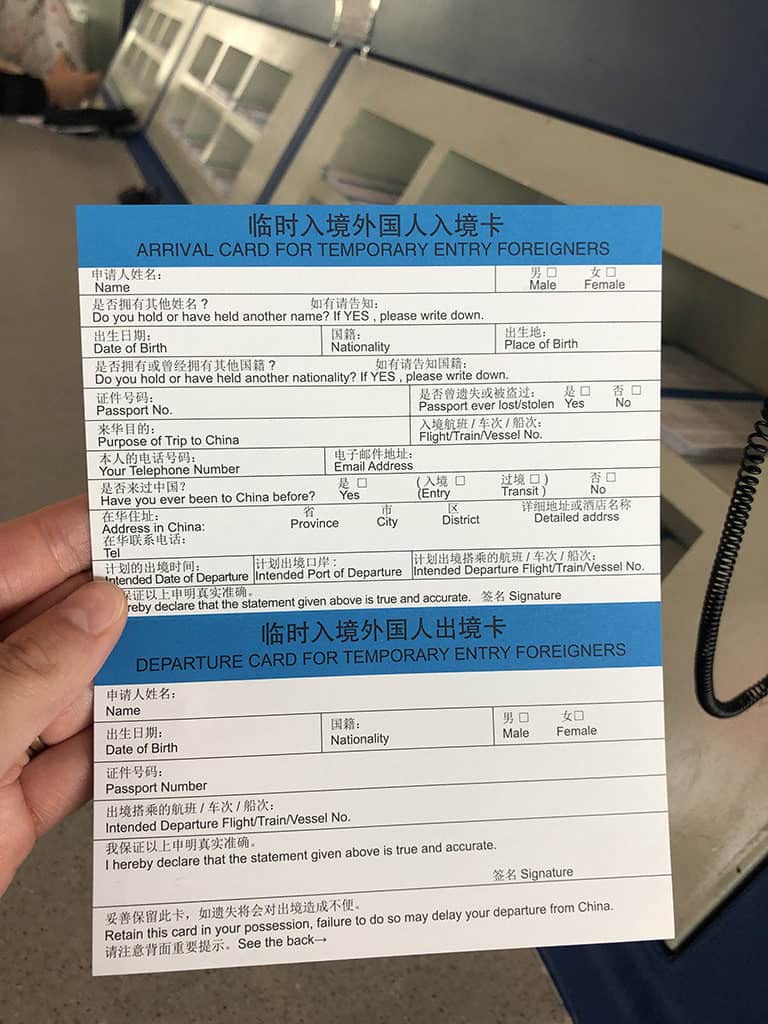
Heading to Shanghai? You can now apply online
For Shanghai specifically, the government created an online way of applying for the 144 hour in-transit visa for the China International Import Expo (CIIE) in 2018. This could alleviate some stress. Note that this is for Shanghai port of entry ONLY.
Online application for Shanghai
The following are the first few steps for applying online.
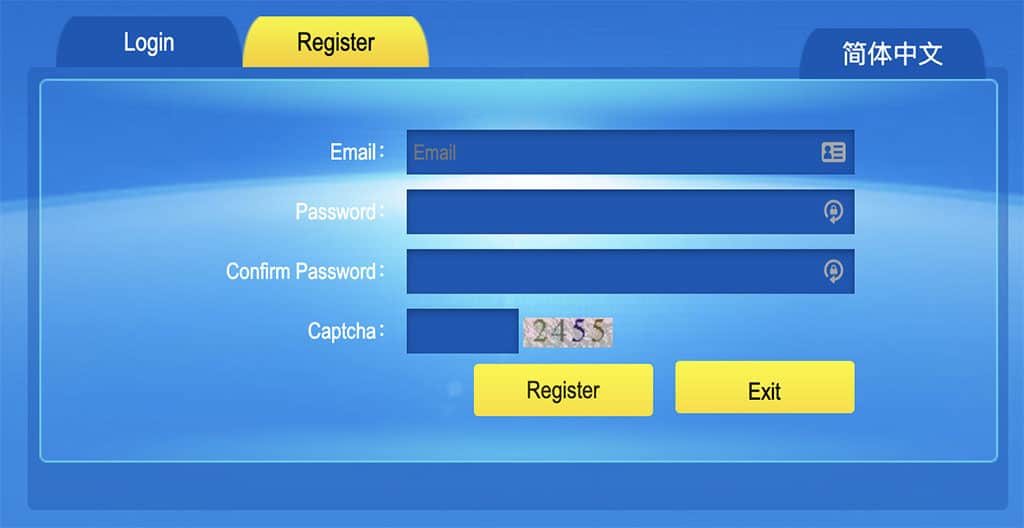
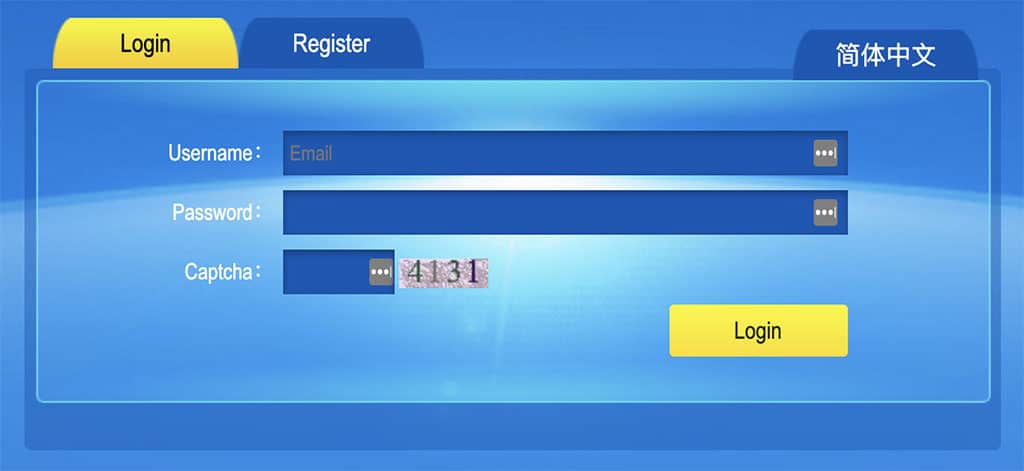
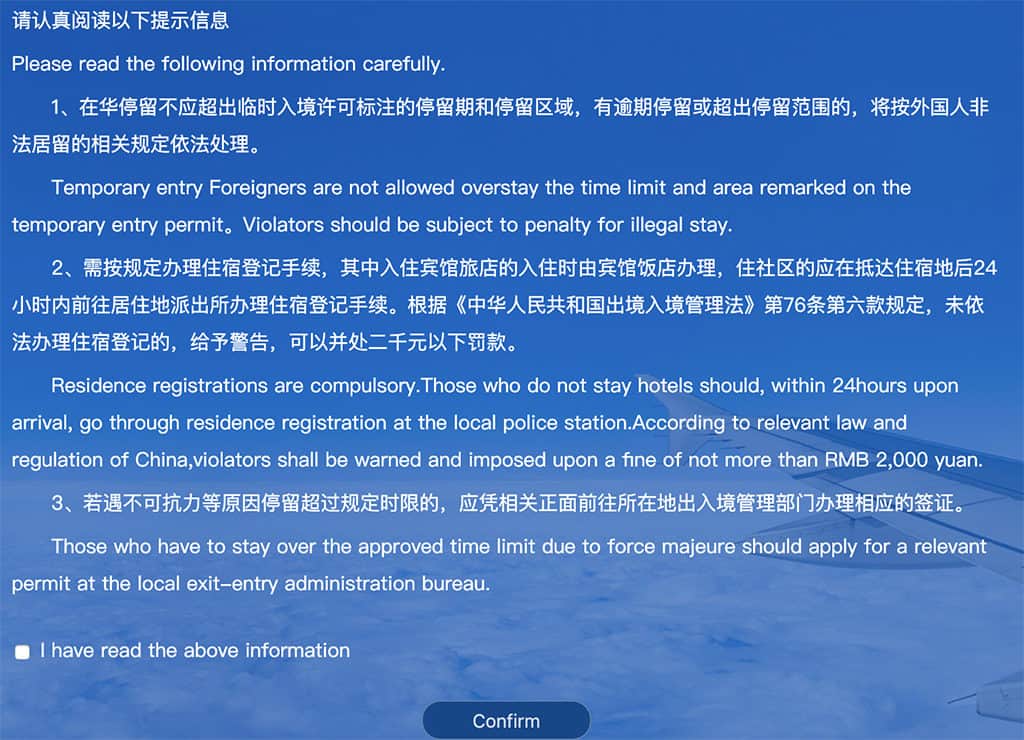
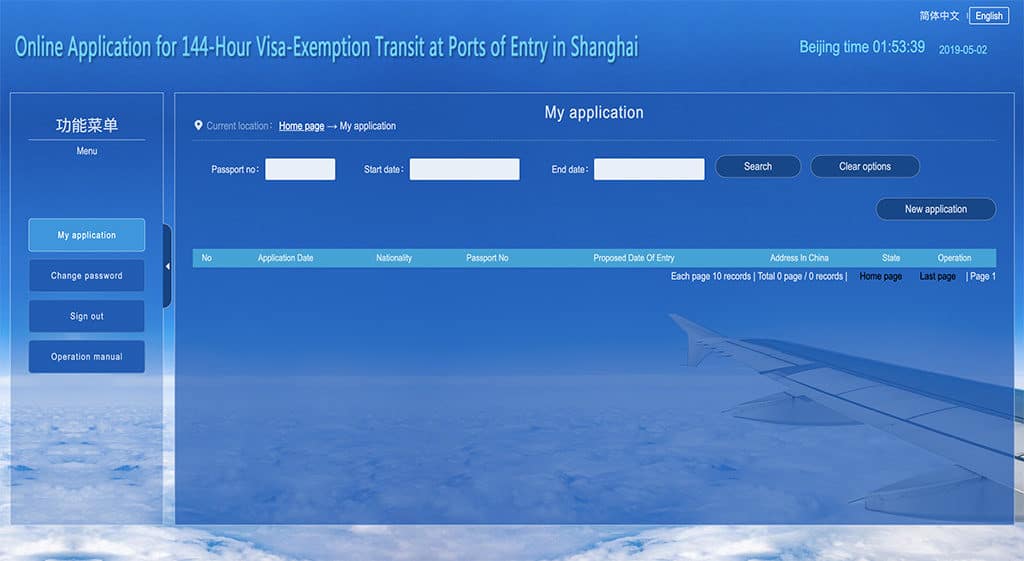
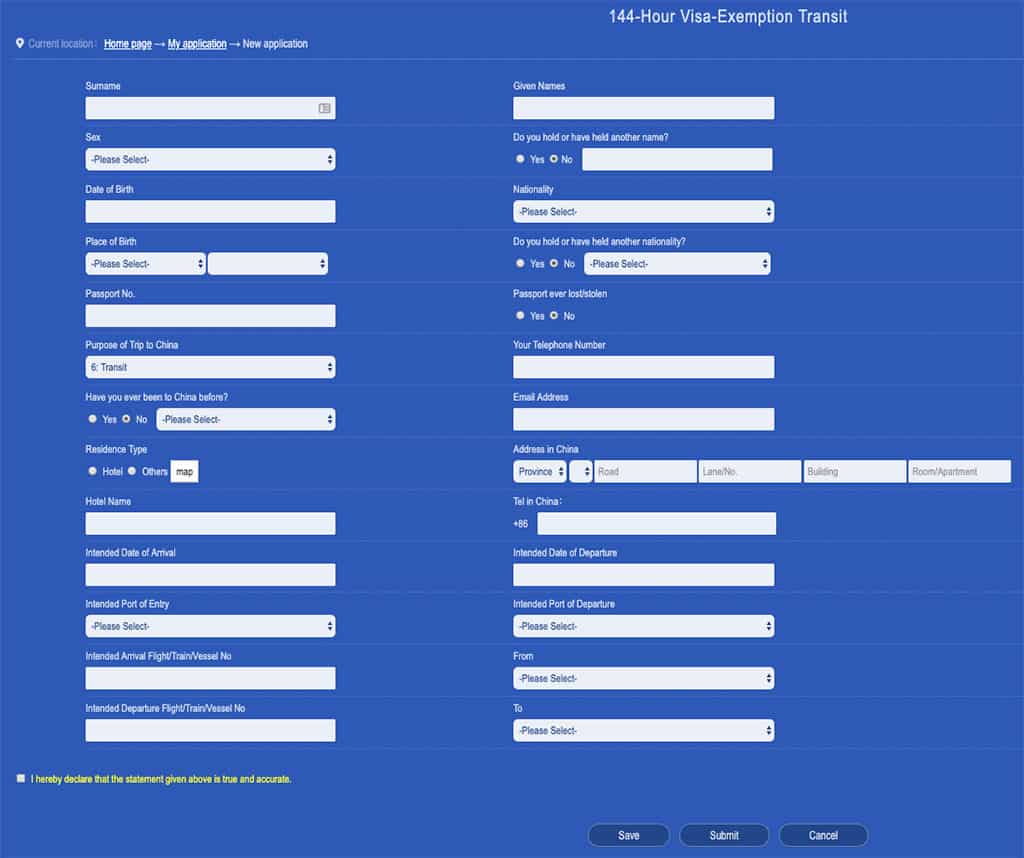
Beyond this, I’d love to hear from those that have actually gone through this process. It looks easy enough to get pre-approval but if the website design is any indication, it’s hard to tell how well it actually works.
Counting 144 hours

This isn’t as intuitive as you think. The 144 hours starts from 00:00 or midnight of the day following your arrival.
For example, if you arrive at 6AM on May 1, the clock starts running once midnight hits to start May 2. As a result, you need to make sure you have a flight that leaves China in the same zone before 23:59 on May 7. If you do the math, that’s actually 162 hours in the country.
A new Chinese government tool
The Chinese government has created a new tool to check whether you’re eligible for the visa-free transit. The site is poorly designed but at least it’s simple and gets to the point. Put in what country you’re from and where you intend to land. If you don’t see the port that you want to enter in then you know immediately that the visa won’t work for you.
Once you’ve selected a valid port of entry, it does a pretty good job at providing the transit requirements, special notes, and a good Q&A.
Does this work for business travellers?
This is another question I’ve seen asked here quite a number of times. Having gone through all the documentation, I don’t see any mention anywhere about the “Purpose of Visit”. It’s one of those things where if there are no specific rules against it, I believe you are okay.
If you want to be 100% sure, since I haven’t done it before, call the embassy in your country and find out.
Inform your airline
If you take a look at some of the comments below from our readers, you’ll see that some have had unfortunate issues with their airline. The truth of the matter is that many/most airlines are not educated on how the in-transit visa works. They are informed to make sure you have a valid China Visa in order to check-in or board your flight. When you don’t have it, they may reject you. That is why it is extremely prudent and recommended to talk to your airline ahead of time to make sure that they understand your situation.
Some airlines will totally get it which means you’re in the clear. If you’re coming from a country and airline that has no idea about the process, then you’ll want to do everything to make sure you don’t have any hiccups on the day that you fly.
What about Hong Kong, Macau, and Taiwan?
This seems like a tricky question at first but transit to that third country or region allows Hong Kong, Macau, and Taiwan. As an example. You can do Canada -> Beiing -> Taiwan. This is allowed as part of the 144-hour transit visa in Shanghai.
The only caveat is that for the third country/region you’re going to, you need to make sure you can prove that you’re allowed to enter that country via a visa. As an example, an e-visa to Taiwan may not be enough.
Clear no-no’s
If you take a look at the comments at the bottom, you’ll see that there are many common questions that come up time and time again so here are a summarized list of what is not allowed for those that are trying to find an itinerary that works:
- The airport that you land in is your entry city and thus zone. For example, if you have to transfer in Beijing but ultimately want to get to Shanghai, this is NOT allowed.
- You cannot you use this visa to do a clear return trip even if you’re transiting through the city on the way in or out. Customs will see the same city FROM and TO and you’ll be denied.
- Any minute you’re over the 144 hours and you’ll be denied even if check-in time puts you under 144. It’s the official take-off time that they look at.
How do you leverage the 144-hour visa?
There are many travel companies that actually now offer 6 day tours especially designed for travellers who qualify for these visas and take you to see sites specific to each zone.
So beyond using this visa in a bind to get to China like it was in my case, you can leverage the 144 hours to see the country in a quick 6 days before moving onto another country in Asia.
The rest of Mary’s story

Will –
Here’s my version of what happened. Mary’s grandfather in Shanghai became unexpectedly ill while in Tokyo and it seemed at first that it would be near impossible to just fly to China. China is one of those countries that takes a bit of planning to go to because most passport holders require a visa to enter. I remember asking around about whether China takes family emergency exceptions as a way to enter the country but everything pointed to “no”. Determined to go, all I remember hearing about was that she was going to buy a ticket that day and just go.
What I didn’t know was Mary had a brilliant albeit a little lucky plan. Mary bought a ticket from Tokyo to Toronto via Shanghai. When she landed in Shanghai and went to the transit visa area of customs, nerves were at an all time high because she had no idea if this was going to work. Custom officials went through her flight information and details of where she was going to stay. Things were looking bleak as they deliberated for an abnormally long time. What was happening behind the scenes was they were counting the hours that were in between her landing in Shanghai to her departure to Toronto. Every hour mattered.
At the end of it all, she just managed to come in at under 144 hours for them to grant the visa. Crazy!
Somehow she had pulled off the impossible. By being in Japan, she managed to unexpectedly detour to China by leveraging this visa-on-arrival.
Did this help? Do you have other unanswered question about the 144 Hour In-Transit Visa? Just drop a comment below and I’ll make sure to get back to you as soon as I can!

Looking for more China content?
What you need to know before travelling to China
Travel Resources For Your Next Trip
If you’re in the process of planning your trip and putting together your itinerary, these are genuinely the best resources that the Going Awesome Places team stands by 100%.
Credit cards: Don’t get burned by hidden fees on top of terrible exchange rates. When we travel now, we use the Wise Card. Simply load it with the currency you need before you go and use it as a regular VISA or their digital wallet card. Use their free app to track how much you have and top up when you need to.
Flights: Of all the booking search engines, Skyscanner is the most helpful and easy to use thanks to their Everywhere feature. Kayak is also another that’s we will often check as well.
Car Rental: If you’re looking to save money, these car rental coupon codes will be a true game-changer. Otherwise, DiscoverCars and RentalCars are great places to start.
Airport Parking: You’ll need a spot to leave your car at the airport so why not book a spot at a discount. Use code AWESOME7 to get at least $5 off at Airport Parking Reservations or Park Sleep Fly packages.
Data: We’ve been a huge fan of wifi hotspot devices like PokeFi because their rates are so good and you can use it globally but recently, we’ve really loved using eSIMs. The best one is Airalo. Save money by getting region-specific eSIMs and use referral code WILLIA9500 to get $3 USD credit on your first purchase. Ubigi is another one that we’ve had success with where they uniquely offer 5G coverage. Use code AWESOME10 to save 10% on your first order.
Hotels: Our go-to is Booking.com because they have the best inventory of properties including hotels and B&Bs plus they have their Genius tier discounts. The exception is Asia where Agoda always has the best prices. TripAdvisor is also useful for reviews and bookings.
Vacation Rentals: Your first instinct will be to check Airbnb but we always recommend checking VRBO as well if you’re looking for a vacation rental.
Tours: When planning our trips, we always check both Viator and GetYourGuide to at least see what’s out there in the destination that we’re going to. They often have different offerings and prices so check both.
Travel Insurance: Learn how to buy the best travel insurance for you. This isn’t something you want to travel without.
- Insured Nomads – Popular insurance provider for frequent travelers and comes with great coverage and special perks.
- RATESDOTCA – Search engine Canadians looking for the cheapest insurance including multi-trip annual policies.
- SafetyWing – A perfect fit for long-term nomads.
- Medjet – Global air medical transportation.
- InsureMyTrip – Best for seniors, families, and those with pre-existing conditions.
If you need more help planning your trip, make sure to check out our Travel Toolbox where we highlight all of the gear, resources, and tools we use when traveling.
